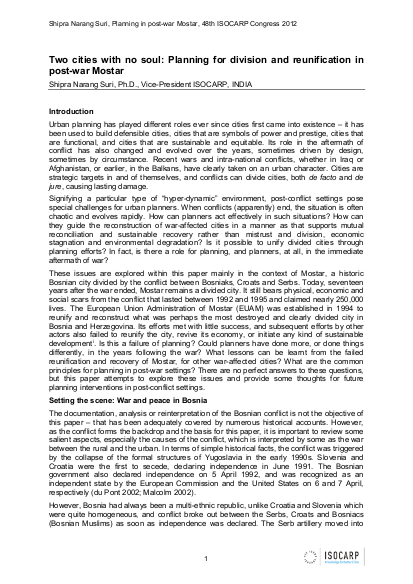
Urban planning has played different roles ever since cities first came into existence – it has been used to build defensible cities, cities that are symbols of power and prestige, cities that are functional, and cities that are sustainable and equitable. Its role in the aftermath of conflict has also changed and evolved over the years, sometimes driven by design, sometimes by circumstance. Recent wars and intra-national conflicts, whether in Iraq or Afghanistan, or earlier, in the Balkans, have clearly taken on an urban character. Cities are strategic targets in and of themselves, and conflicts can divide cities, both de facto and de jure, causing lasting damage. Signifying a particular type of “hyper-dynamic” environment, post-conflict settings pose special challenges for urban planners. When conflicts (apparently) end, the situation is often chaotic and evolves rapidly. How can planners act effectively in such situations? How can they guide the reconstruction of war-affected cities in a manner as that supports mutual reconciliation and sustainable recovery rather than mistrust and division, economic stagnation and environmental degradation? Is it possible to unify divided cities through planning efforts? In fact, is there a role for planning, and planners, at all, in the immediate aftermath of war? These issues are explored within this paper mainly in the context of Mostar, a historic Bosnian city divided by the conflict between Bosniaks, Croats and Serbs. Today, seventeen years after the war ended, Mostar remains a divided city. It still bears physical, economic and social scars from the conflict that lasted between 1992 and 1995 and claimed nearly 250,000 lives. The European Union Administration of Mostar (EUAM) was established in 1994 to reunify and reconstruct what was perhaps the most destroyed and clearly divided city in Bosnia and Herzegovina. Its efforts met with little success, and subsequent efforts by other actors also failed to reunify the city, revive its economy, or initiate any kind of sustainable developmenti. Is this a failure of planning? Could planners have done more, or done things differently, in the years following the war? What lessons can be learnt from the failed reunification and recovery of Mostar, for other war-affected cities? What are the common principles for planning in post-war settings? There are no perfect answers to these questions, but this paper attempts to explore these issues and provide some thoughts for future planning interventions in post-conflict settings.
Resource collections
- Climate emergency
- Topics
- UN Habitat - Urban Response Collection
- Urban Response - Urban Crisis Preparedness and Risk Reduction
- Urban Response Collection - Community Engagement and Social Cohesion
- Urban Response Collection - Economic Recovery
- Urban Response Collection - Environment and Climate Change
- Urban Response Collection - Housing, Land and Property
- Urban Response Collection - Urban Crisis Response, Recovery and Reconstruction
- Urban Response Collection - Urban Resilience
